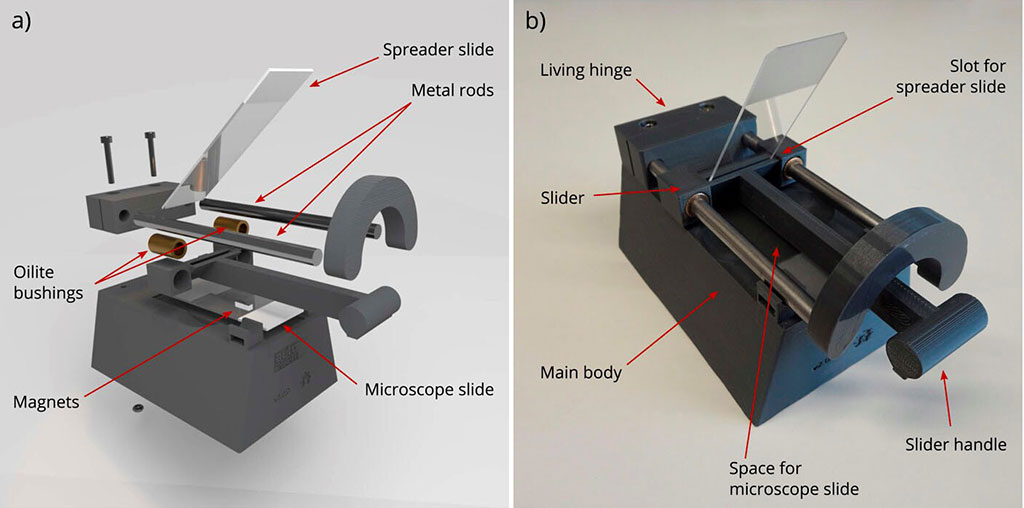Automating Blood Smears Developed for Easier Malaria Diagnosis
By LabMedica International staff writers
Posted on 03 Feb 2022
Blood smears are used in diagnosis for a variety of hematological disorders, such as anemia and leukemia. They are also the preferred method of diagnosis of parasitic infections, such as malaria and filariasis in developing world laboratories. Posted on 03 Feb 2022
The current “gold standard” for malaria diagnosis is by optical microscopy examination of blood smears. A thin film of the patients’ bloods is fixed onto a microscope slide and stained. The microscopists look at the smear, counting the parasites in various fields of view. These experts can establish the species of malaria and parasite density.

Image: (a) 3D-rendered exploded view of autohaem smear showing the non-3D printed parts. (b) Photo of an autohaem smear showing the assembled device with the two microscope slides in their positions (Photo courtesy of Cambridge University)
Bioengineers at Cambridge University (Cambridge, UK) collaborating with their colleagues in Tanzania and the UK created a series of devices, which they call “autohaem.” Autohaem devices aim at enabling even non-experts to produce consistent, high quality, thin film blood smears at low cost. The autohaem devices, solves this problem by automating the smearing process so every smear is correct and consistent. The devices come in two varieties, the autohaem smear and the autohaem smear+, the latter of which is fully automated with a motorized smearing mechanism. In tests, inexperienced technicians were able to use the device to produce expert-quality smears.
A key goal of the project was to make the devices accessible to as many people as possible, so the scientists designed their devices to be easy to build, using readily available or 3D-printed components. A pipeline for automated analysis of smear quality was presented and used for device optimization. Red Blood Cells (RBCs), at the typical hematocrit for malaria investigations, are used as the testing media. This pipeline will also be suitable for a more systematic analysis of blood smear preparation, for example, to help with training and evaluation of technicians.
Samuel McDermott, PhD, the senior author of the study, said, “Creating blood smears is a laborious, repetitive task that requires an expert level of skill and manual dexterity. By using automated blood smearing machines, such as autohaem devices, technicians will be able to increase their throughput while maintaining a high enough quality for diagnosis. In some countries, up to 81.5% of blood smears are prepared incorrectly. If a blood smear is prepared incorrectly, when examined under a microscope, the technician will struggle to make a correct diagnosis. Because these smears are often made in a rural clinic and sent to a regional facility for examination, any issues in the smear could cause days of delay.”
The authors concluded that they have developed and presented the autohaem range of devices for automated blood smearing. Autohaem smear is a mechanical device, and autohaem smear+ is an electro-mechanical device. The devices are designed to be sustainable and all the designs and assembly instructions are available under an open source license. The study was published on January 18, 2022, in the journal Review of Scientific Instruments.
Related Links:
Cambridge University













